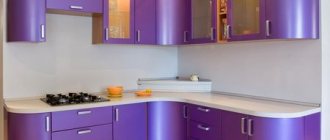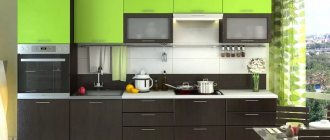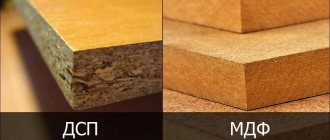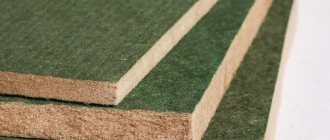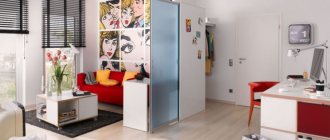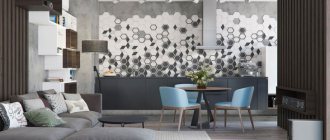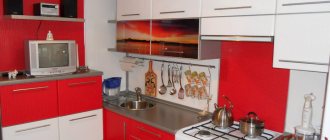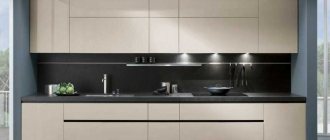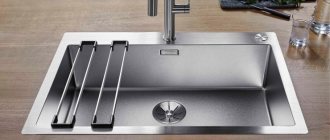Many customers of cabinet furniture initially do not understand what material it should be made of and what they should pay special attention to. Some questions can drive you into a blind corner - for example, what is better for the kitchen, MDF or chipboard, what should the set be made from so that it lasts for several years and does not lose its former attractiveness?
Experienced furniture makers will always tell you that this kind of furniture in the kitchen is used in conditions of high humidity, large temperature changes, and regular mechanical and chemical influences. All these factors must be taken into account when designing a headset.
Properties of MDF
First, it is worth considering the most important properties of each material separately. As for MDF, it is a board made from fine wood fraction. It is dense, resistant to mechanical stress, thickness varies from 2 to 60 mm. The name MDF comes from the English abbreviation MDF, which means “medium density wood board”.
Note! MDF is absolutely safe for health, does not emit toxic fumes, and is similar to natural wood.
A distinctive feature of MDF is its plasticity and the ability to be processed with cutting and drilling tools. It is easy to make holes and grooves in the slabs, cut out patterns on the surface, and chamfer them with a router. The sheets can be bent to obtain radius facades. This allows you to make furniture of very different configurations.
The surface of the plates can be sanded, covered with PVC film, painted with glossy or matte enamel of any color. When pasted with natural veneer, the material is difficult to distinguish from solid wood; in appearance it is very similar to it, and even superior in strength.
Furniture made from MDF can be installed in rooms with humidity reaching 70%. There are also more moisture-resistant modifications with special impregnation; slabs with fire-resistant properties are produced. Furniture made from this material is great for the kitchen, bathroom, bedroom, and children's room.
What is MDF - pros and cons for the kitchen
MDF material appeared in the USA in the middle of the last century. He came to Russia only in the late 90s. The basis for its manufacture is wood shavings. It is finely ground, so that in the finished MDF sheet the wood fibers are almost invisible. The surface looks uniform, almost like a solid piece of wood.
To make it clearer what is more suitable for the kitchen - chipboard or MDF, let's look at the difference in the manufacture of these materials.
MDF production stages:
- Wood processing, grinding sawdust to a powder texture.
- The ground chips are washed to remove contaminants and sent for drying.
- High pressure pressing. During the process, the wood fibers become very hot, which leads to the release of a natural resin called lignin. This natural adhesive connects all the fibers together, resulting in a durable and safe material for furniture.
- The finished sheets are sanded, after which the surface is even and smooth. This processing allows you to adjust the product to the desired thickness.
The last stage is coating with a finishing layer. MDF cladding is varied in color and texture, which makes it possible to create a kitchen to suit any interior.
Types of MDF processing
MDF sheets have a uniform, smooth surface, which allows finishing in a variety of ways. This increases the variety of choice and allows you to create your own unique kitchen design.
Based on the type of finishing, there are 4 types of MDF processing.
- Sanded - The sheet is sanded on one or both sides. The surface can be covered with a layer of putty and painted with any type of paint.
- Laminated - sanded MDF board is covered with a polymer film of various colors or imitating the pattern of natural wood. It looks aesthetically pleasing and is produced in a variety of color variations.
- Veneered - a thin layer of wood is applied to the surface of the slab. The material takes on the effect of natural solid wood. MDF made using this technology is sold at a higher price than other types. It is distinguished by external nobility, high aesthetics, the kitchen looks expensive and presentable.
Varnished - after sanding, the sheet is covered with a dense layer of varnish. This gives moisture resistance, which is especially important for the kitchen. This coating option has one drawback - for a flawless appearance, the surface requires constant care; hand marks on it are very noticeable.
Pros of MDF
More modern production technology gives MDF a lot of important advantages:
- Furniture in the kitchen is not harmful to human health. Formaldehyde or other chemicals are not used to join MDF wood fibers, unlike chipboard and laminated chipboard.
- Resistance to damage, humidity and temperature changes.
- The surface of MDF kitchen furniture is smooth, does not absorb dirt, so it is easier to care for.
- Resistance to fungus formation.
- Variety of colors.
- Ease of processing - you can even build the necessary furniture for the kitchen with your own hands from MDF without much difficulty.
Characteristics of MDF kitchen worktops:
- They do not deform under the influence of high temperatures, you can place hot dishes and not be afraid of damage to the surface.
- Do not change appearance with constant exposure to sunlight.
- When applied properly, PVC film does not absorb moisture and does not swell.
- No traces of tea and coffee remain on the surface.
Cons of MDF
The main reason why people often refuse to purchase a kitchen set made from MDF is its high price compared to chipboard and laminated chipboard. But still the cost is lower than that of solid wood.
Possible negative properties of the material:
- Prolonged exposure to high temperatures can lead to splitting of the layers of the kitchen set.
- It is better not to use alkaline products for washing kitchen furniture made of MDF; alkali can damage the material.
- Untreated parts of the sheet absorb moisture, which can cause the material to swell over time.
- Wire brushes and abrasive cleaners should not be used on glossy surfaces to avoid scratches.
- The varnished surface of MDF may become cloudy due to constant exposure to water evaporation.
- Over time, kitchen furniture can become wobbly as the material loses its original strength.
If MDF furniture in the kitchen is properly cared for and used carefully, then the manifestation of the listed shortcomings can be avoided.
Properties of laminated chipboard
Laminated chipboards (LDSP) are characterized by low cost, resistance to temperature changes and a wide range.
The laminated coating can be made in almost any color and texture, which allows you to choose laminated chipboard furniture for the interior in any style. It belongs to the economy class because it has an affordable price.
Furniture made entirely of laminated chipboard has straight lines and looks more laconic even with a beautiful image on the film.
It should be noted that chipboard is used to make a durable material lined with plastic, which is called postforming. It goes into the production of countertops. However, this is not laminated chipboard in the usual sense.
Among the disadvantages of laminated particle boards are the tendency to chip on the surface and the impossibility of milling. The latter property makes it impossible to obtain smooth angles and bevels, or a relief surface.
LDSP differs from MDF for the worse in that it is less resistant to moisture. Although there are also moisture-resistant types of panels, their price is much higher.
If part of the laminate breaks off from the chipboard, the board may emit harmful fumes. This is also a disadvantage, since we should not forget that formaldehyde glue is used to adhere the chips in the slabs. Melamine film can protect against fumes of toxic formaldehyde. It is from this that lamination is made. Manufacturers make sure that the film adheres to the surface as firmly as possible, completely covering it. The safety of laminated chipboard largely depends on its quality.
Note! If the question arises about what is better to choose for the bedroom: laminated chipboard or MDF, then you should opt for the second one or prefer a combined option.
However, certified products that meet European standards (class E1, indicated in official documents) are quite safe to use in any residential area. It is best to choose (if possible) products made in Austria and Germany. At the same time, it is important to properly care for it, avoiding damage.
Which material is suitable for kitchen furniture: comparison
To understand whether it is better to buy furniture made from laminated chipboard or MDF for the kitchen, you need to compare their positive and negative qualities.
Durability
Of course, when purchasing various pieces of furniture for the kitchen, we plan to use them for many years in a row, so it is necessary to choose the most durable material. As we mentioned above, low-quality furniture will quickly become unusable, and the kitchen will have to be replaced every two or three years, which is completely unprofitable.
MDF has better wear resistance
Furniture made from MDF is characterized by the highest durability (this feature is due to the almost natural composition of this material), and structures made from laminated chipboard will quickly lose their original appearance. If you provide good care for MDF furniture, it will definitely serve you for many years.
Resistance to various damages and negative impacts
Kitchen furniture must be resistant to various impacts and other damage. Of course, products made from MDF have better resistance to wear and oil stains. However, such a surface will suffer from constant exposure to steam or any liquid, and this will become noticeable within a few years. Furniture made from chipboard is less likely to deform under such conditions.
Laminated chipboard is stronger due to the synthetic resin in its composition
Otherwise, I would like to note that furniture deteriorates and breaks with equal frequency due to various mechanical damages, so it is difficult to select the best of the two materials. Note that laminated chipboard has a higher resistance to scratches, moreover, these surfaces can be washed without fear even with strong chemicals.
Environmental Safety
The content of toxic components in the composition negatively affects human health, so this point cannot be ignored. And since laminated chipboard still contains formaldehyde, albeit in small quantities (E1), purchasing such furniture is a risk, especially if kitchen furniture is made from it. Therefore, despite the large number of positive qualities, many refuse this lumber.
Chipboards may have a specific odor due to formaldehyde
Note! We should take a short digression to understand how synthetic resin affects health. This poison affects the nervous system, respiratory organs, liver, and kidneys. In addition, the substance irritates the mucous membranes of the eyes and provokes an allergic reaction.
The use of MDF in the kitchen, in turn, does not in any way affect people’s well-being, so if we evaluate materials on this point, then MDF is clearly the leader.
Aesthetic features
The attractive appearance of a kitchen is sometimes the main criterion by which it is chosen. Here, the two materials we are considering do not have any particular advantages over each other, since the modern furniture industry offers a lot of kitchen models made from both MDF and laminated chipboard. The choice is always a matter of taste, so for each buyer the conclusion about the external attractiveness of such furniture will be individual.
An example of an aesthetic kitchen made from chipboard
But, if you want to purchase a kitchen with various shaped elements, then of course you should choose MDF - laminated chipboard, due to its greater rigidity, is not suitable for the manufacture of such furniture elements. I would also like to note that laminated chipboard has a wide variety of shades, and if you are looking for furniture in bright or unusual colors, then you should take a closer look at this material.
General requirements for care and operation
When choosing a place for furniture made of MDF or laminated chipboard in the kitchen, you must take into account that both materials are resistant to temperatures above 75 ℃. When exposed to high heat, the coating begins to peel off. For this reason, heating devices should not be placed in close proximity to furniture.
If a furniture set is constantly illuminated by the bright sun, then it may simply fade and lose its attractiveness. Chipboard lamination is especially susceptible to fading.
Severe wetting of the slabs is undesirable, although they can withstand short-term exposure to water well, which is why they are used for sinks and other kitchen furniture. Much depends on the quality of the material. There are often cases when laminated chipboard sheets begin to become saturated with water, swell, and crumble. Such furniture takes on a terrible appearance, is destroyed, and becomes completely unusable.
General rules of care are:
- wipe the dust with a dry cloth or a special compound for plastic;
- promptly remove moisture from the surface with an absorbent sponge;
- do not overload hooks and shelves so that fasteners do not break off;
- Do not use waxes and mastics intended for polished wood.
The last point is worth focusing on. Polishing agents intended for wood are not suitable for MDF and laminated chipboard. The laminated film may change color under their influence and even peel off. You should also not use acids, alkalis, or abrasives.
Both types of slabs are resistant to pests and mold. In a dry room, they can stand for decades without any additional treatment without collapsing. They are used to make beds, tables, cabinets, chests of drawers, bookcases, shelves, and all kinds of kitchen cabinets.
Kitchen furniture: features
Quite often, well-known manufacturers prefer to use MDF and laminated chipboard when creating kitchen furniture. At the same time, serious requirements are placed on products installed in premises of this type - they must withstand temperature changes, high humidity and other negative influences. The materials we are considering are believed to have similar properties.
It is worth noting that most consumers consider the quality of furniture last. For many, appearance always comes first. Nevertheless, quality is a very important criterion, because the durability of the kitchen, aesthetics, and the general perception of the room depend on it.
Kitchen furniture must be reliable
In addition, kitchen furniture must remain in its original form, even despite frequent washing with chemicals and the negative effects of temperature and humidity. If the set does not meet these criteria, then in the first year the owners will be disappointed in the purchase, and the question will arise about renovating or buying a new kitchen. Of course, no one would want this, and therefore we recommend that you read this text carefully so as not to make a mistake with your choice.
External differences in materials
Many people are interested in how MDF differs from laminated chipboard in appearance, and how to identify them? The difference is clearly visible in the cut. In MDF it is dense, fine-grained, in chipboard or laminated chipboard it is more heterogeneous, rough, and shavings are visible. On the surface of chipboard without lamination, fibers and shavings are clearly visible, while MDF is more uniform.
If you take MDF and laminated chipboard boards of the same size (in area and thickness), then the weight of the particle board will be less than that of fine particle board.
If there is a milled, carved surface on the material, we can definitely say that it is not laminated chipboard, since nothing can be cut on it. You can’t make small parts from it either, since the material will crumble.
Chipboard and MDF - what's the difference?
Due to the difficult situation of the post-war period, many industries were forced to look for alternative materials for the manufacture of products. Although wood was considered the most expensive option, it was still unaffordable for many buyers. In view of this feature, a new material was introduced, which was lower in cost, but in terms of quality characteristics was practically not inferior to natural wood.
A more “correct” abbreviation is considered to be not chipboard, but chipboard.
If we bypass all the subtleties of the manufacturing process of this material, we can say that both MDF and chipboard are firmly compressed lumber, which are glued together with special viscous resins. Safety, service life and scope of application of materials directly depend on what resins were used, in what quantity, and what quality. Such details as the grain size of the lumber and the pressing force are also taken into account: the less sawdust and the greater the pressing force, the better the product.
Advantages of MDF over laminated chipboard
So, after comparing two types of wood-based boards, we can come to the conclusion that, in general, MDF differs from chipboard for the better. The advantages of MDF are as follows:
- no chips are formed on the edges, in places where screws are tightened;
- is characterized by high density and strength;
- the material is environmentally friendly;
- more resistant to moisture than laminated chipboard;
- MDF can be bent, milled, and therefore create beautiful shapes and designs.
The advantages affect the price. Typically, the cost of fibreboards is higher than that of particle boards. If MDF is combined with metal, glass, made in accordance with the original design solution, and decorated, then its price increases even more. At the same time, such furniture, whether it is in the kitchen or in the bedroom, requires more careful care.
In which kitchen interior is it better to use MDF, and in which laminated chipboard?
If you plan to design a kitchen in a certain style, then you need to take into account differences in the properties of materials. Designers advise adhering to the following recommendations.
- For a kitchen in a classic style, MDF without a paintable finish is ideal; you can choose the desired color for it, and make some elements of the kitchen furniture shaped.
- In a high-tech kitchen, everything is strictly and concisely, without carved elements, so you can choose laminated chipboard.
- As in the classics, for a kitchen in the Provence style it would be ideal to use MDF with a smooth, fine-grained surface for painting.
- In laminated chipboard, the quality of the glossy finish is slightly better and is more suitable for an art deco style kitchen. But MDF will also be quite good in this design.
Comparative characteristics of materials
Looking at these materials, you can see that they differ from each other in many ways for various reasons. The main distinguishing features are described below:
| Comparison criteria | laminated chipboard | MDF |
| Quality | average | high |
| Environmental friendliness | contains harmful substances | contains no harmful substances |
| Material Density | solid | soft |
| Moisture resistance | weak | average |
| Price | cheap material | high price |
| Design | a wide range of | small assortment |
When shopping, many people often think: “What is better to buy MDF or laminated chipboard?” These materials cannot be distinguished even by touch, but they have different characteristic qualities.
Main Differences
Laminated chipboard differs from MDF in the subtleties of its composition and production features. Unlike MDF, laminated chipboards are affordable; this material is specially designed for the manufacture of budget furniture.
MDF, in turn, can boast of a detailed finish that is not available for furniture made from laminated chipboard. But medium-resistant fiberboard also costs an order of magnitude more. Either way, MDF is more affordable than solid wood furniture.
Compound
Both materials include remnants of the wood industry, such as sawdust and shavings, but are completed with chipboard and MDF with some differences. Approaches to production vary depending on the needs of customers, that is, on the specific purpose for which they require the material.
Expert opinion
Karnaukh Ekaterina Vladimirovna
Graduated from the National University of Shipbuilding, majoring in Enterprise Economics
When creating furniture from chipboard, formaldehyde resin is used, thus giving the material density, and subsequently the furniture is laminated.
MDF is based on a finely dispersed fraction of wood; particles of shavings and sawdust are much smaller in size than in laminated chipboard, and the material itself does not emit toxic substances, while being much denser than its competitor.
External differences
Laminated chipboard slabs are loose and chaotic in appearance, especially on the scar side, thanks to which it is possible to distinguish one material from another. Despite the limitations in decorative finishing, laminated chipboard can be covered with a finishing film that can impart visual qualities to various surfaces: stone, wood.
In turn, MDF allows customers to give free rein to their imagination and order in-depth patterns and designs on the surface of the slab that imitate wood carving. MDF boards are scratch-free and easier to cut during production, making the material look more solid, nicer and richer.
Density and strength
The materials laminated chipboard and MDF differ both in wear resistance and in such parameters as density and strength. Therefore, it is very important to understand for what room and use this or that material is selected.
Laminated chipboard is loose in composition; often lower-quality wood chips are used for its production. Processing the material with resin increases the strength of laminated chipboards, but the material becomes less environmentally friendly.
Water repellent properties
A small amount of water getting on the laminated chipboard is not critical, but it is better to promptly wipe the wetted surface with a dry cloth. Laminated chipboard and MDF materials equally do not withstand contact with water very well, causing them to swell and become irreparably deformed. In this regard, MDF is superior to laminated chipboard, but both coatings are not completely protected from the harmful effects of moisture.
When using chipboards, it is very important to take care of the processing of the end parts of the components so that ingress of water does not cause significant damage. The most important places are cuts at corners, where the action of water can be critical. The material easily swells and changes shape, therefore, to slow down the negative effect, you can glue such places with melamine or a substance with similar characteristics. The optimal solution for protecting laminated chipboards from moisture is to treat the end parts with sealing substances.
Expert opinion
Karnaukh Ekaterina Vladimirovna
Graduated from the National University of Shipbuilding, majoring in Enterprise Economics
MDF is often used for finishing furniture facades. This approach is used due to the increased water-repellent properties achieved through paraffin treatment. Hence the safety of this type of material, which is optimal for use in kitchen areas.
Production technology and environmental friendliness
Laminated chipboard is made from recycled wood waste and coated with a special bonding resin. Because of this, it is better to buy furniture made from chipboard for utility rooms, since this type of surface emits harmful resin fumes, which makes it undesirable for use in bedrooms.
Furniture made from MDF benefits from its competitors in many ways, for example, being more environmentally friendly. Therefore, MDF is most suitable for finishing bedrooms, children's rooms, and living rooms. It makes beautiful looking bedside tables, cabinets and various finishing elements. In addition, during production, MDF can be bent to give it various decorative shapes, which cannot be done with laminated chipboard.
Durability of the coating
If we talk about wear resistance, then, as has been noted, furniture made from MDF wins in this regard unconditionally. Such material will last longer and will be less susceptible to adverse external effects. Meeting the demands of hygiene, this furniture is significantly less susceptible to the harmful effects of fungi and microorganisms, and facades made from such a coating always look presentable.
The laminated chipboard material has a number of its own specific features that distinguish the rules for its long-term use. In case of frequent exposure to water, laminated chipboard, even with the necessary treatment with protective agents, gets wet and loses its shape much faster than MDF surfaces.
Material price
The main feature of laminated chipboard finishing materials is their budget price. This aspect determines the popularity of laminated chipboards in furniture production.
MDF, at the same time, is somewhat more expensive, but the decorating effect is impressive. Such furniture will be better finished, and thanks to the treatment with high-quality substances, it is environmentally friendly and safe.
Advantages and disadvantages
The pros and cons of the material depend on its application and price. For example, more expensive MDF panels with water-repellent laminated film are used in expensive furniture sets for both the kitchen and bathroom. The product is not afraid of water, its structure is denser, which allows it to be used for various purposes. Accordingly, the price of such a canvas will be higher than a similar product of low density and coarse grain. In general, the advantages and disadvantages depend on the type of material; MDF and chipboard have different quality characteristics.
Chipboard
A budget material made from coarse wood shavings. The advantages of the material are its price; it is literally the cheapest option for repairing or making furniture. But you shouldn’t expect high performance indicators. The meaning of this abbreviated designation is particle boards. Due to the absence of a laminated layer, chipboard does not withstand prolonged exposure to moisture; the material also reacts negatively to temperature changes and exposure to direct sunlight. After a short period of operation, the slab may become deformed or even break.
There are two types of chipboard: E1 and E2. The first is safe due to lower formaldehyde emissions. The second type is prohibited from being used for the production of children's furniture.
The safest materials are considered to be Austrian, Japanese and German chipboards.
An important point is the features of using chipboard. Due to the presence of an adhesive, the material is able to firmly fix a screw or nail. But if the slabs are dismantled, when they are reattached there is a risk of deformation of the entire structure.
laminated chipboard
It is a more durable material than chipboard. The difference is that the top layer of the slab (paper-resin films) can withstand exposure to moisture and temperatures. The so-called laminated coating allows you to extend the service life of the finished product. Advantages:
- wide range of colors and textures;
- imitation of wood and other materials;
- resistance to mechanical damage;
- temperature resistance.
For the manufacture of laminated chipboards, only high-quality polished chipboards with high density are used.
MDF
MDF boards are an already improved version of lumber. The same formaldehydes or lignin and paraffin are used as an adhesive. At the final stage, the slabs are covered with a polymer film, carbon or melamine resin. Due to this protective layer, the material is not afraid of moisture, is resistant to abrasions and scratches, and can serve for a long time. Less commonly, a special varnish that does not allow moisture to pass through is used as a protective layer.
Manufacturers' trick: pay attention to the technology used: lamination or laminating. The latter method is cheaper and visually indistinguishable, but durability cannot be guaranteed.
Advantages:
- environmentally friendly material;
- soft material, pliable for fine processing;
- used for facades;
- has the virtues of wood;
- lower price than natural solid wood.
Let's sum it up
So, we have assessed all the main advantages and disadvantages of MDF and laminated chipboard. We can conclude that MDF boards are more environmentally friendly, and if your financial capabilities allow, then do not skimp on purchasing such furniture.
If you only have a limited budget for furnishing your kitchen, then it is advisable to buy furniture made from chipboard. However, you should avoid purchasing hazardous material marked E2 - it is absolutely not suitable for making kitchen furniture.
Video – MDF or chipboard: which is better?
Painted facades
Painted facades can be ordered in a wide range of colors. They can be:
- matte;
- chameleon;
- pure color;
- steel metallic.
The advantage of such facades at a fairly high price category is their long service life.
A high-quality facade cannot contain foreign inclusions or roughness. Visual inspection shows a perfectly mirror surface.
This is achieved by grinding at different levels:
- primer;
- dye;
- varnish
This façade is made using special technology and requires precise execution of all stages. The resulting result will please the owners for a long period of time. It is for this type of MDF that it does not matter whether it is painted on one or both sides. Such panels are not afraid of water, steam, or moisture.
Experts who make furniture do not recommend choosing facades based on chipboard or plastic with its application on one side. Caring for a painted facade requires cleaning approximately every six months. Ease of maintenance depends on the ergonomics of furniture designs. Surface care is simple.
A regular window cleaner will work for this. If any grease stains remain, you can wipe them with a sponge or cloth with detergent.
The surfaces are fairly easy to clean and are not susceptible to heavy contamination.
